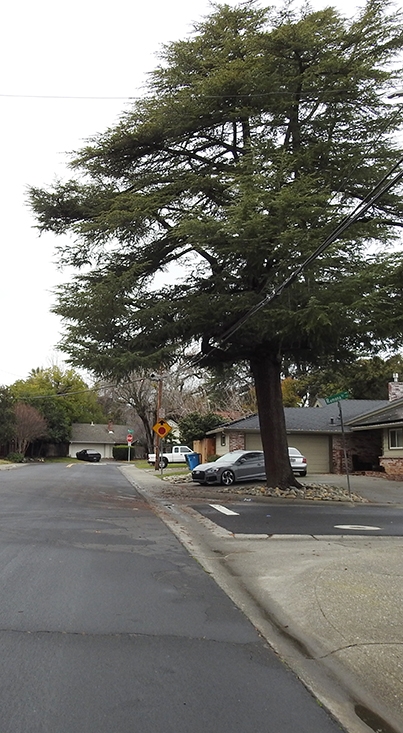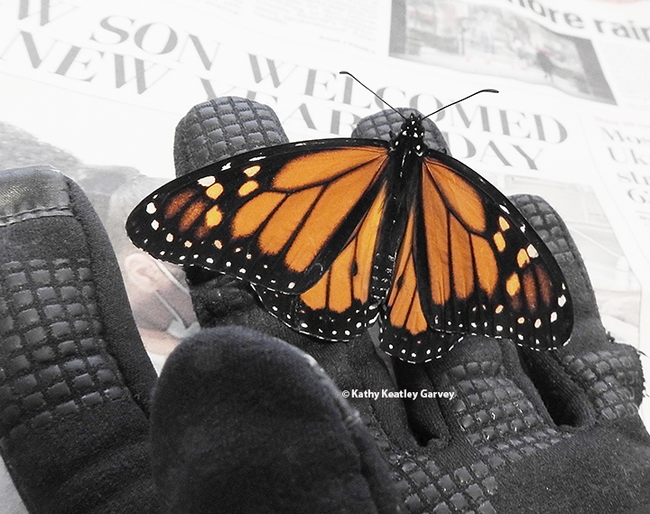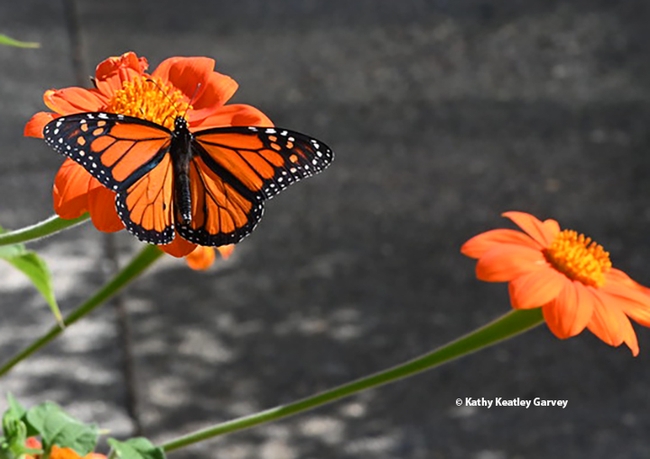
It looked newly emerged but it wasn't moving.
In fact, it looked quite dead.
A gloved hand quickly rescued the monarch, a male, from passing traffic.
A monarch in January? Here in Vacaville after heavy rain and flooding and more on the way? "A third atmospheric river storm," National Public Radio (NPR) announced Jan. 2, "is set to add to misery in California's flooded areas. Forecasters in Northern California have a sobering new-year message for people who are reeling from floods and mudslides: the situation could get worse before it gets better."
"Much like the end of 2022 storm, this will be a strong wind event along with moderate to heavy rainfall," according to the National Weather Service.
Rain, floods, and recent freezing temperatures....
So how incredible to find a monarch here in January, while its "clan" is clustering in overwintering spots along the California coast. (They won't be heading inward until around February.)
"How long has it been seen you saw Monarchs flying in your area?" asked Mona Miller, who administers the popular Facebook page, Creating Habitat For Butterflies, Moths, & Pollinators. "Another option is that if it found a microclimate, which protected its cycle it has been slowly finishing its cycle. With climate change and fluctuating temperatures, I have been seeing late Monarchs surviving several frosts. Once they make it to adults, fall to winter Monarchs become more cold tolerant. This cold tolerance is rapid and protects them from fluctuating temperatures caused by climate change."
The last monarch I saw flying in Vacaville was on Oct. 26, 2022. It was a male that stopped to nectar on our Mexican sunflower (Tithonia rotundifola). The blooms are long gone. We're in the dead of winter.
But there's hope.
"The ongoing wild windy wet weather in California is the wild card that interferes with predictions about the summer population in 2023," James commented. "Wild late winter storms are likely what caused the substantial reduction (from ~ 200,000 to 30,000) in western monarch numbers back in 2018/19. These lower numbers then led to the ultra-low number in 2020 of 1899 overwintering butterflies. Then of course we rebounded to more than 247,000 in 2021 and likely more than 300,000 for Nov 2022."
"The question now," James said, "is will the current storms and any others that occur during January-February, savagely dent the population as the 2018 storms did? If the overwintering population can survive the storms without major losses, then I think we will see a good-sized summer population in California and the Pacific Northwest in 2023." He administers the Facebook page, Monarch Butterflies in the Pacific Northwest.

It's sponsored by the Western Monarch Advocates (WMA) and is open to all interested persons--from scientists to citizen scientists to monarch aficionados. It will include networking, field trips, and meals.
James, a WMA board member, will be among the keynote speakers from four countries. The event is billed as "an exchange of ideas from across the Western States, Tribal Lands, Mexico, Canada and Australia-all with an interest in our western monarch population! Expand your knowledge and make connections with other Monarch enthusiasts, researchers, and conservation organizations."
As they point out, "our migrating Western Monarch butterflies do not stop at state or international borders; nor should our efforts to restore them."
And, apparently, the Vacaville monarch lying cold and still on a residential street on Jan. 3 didn't let the rain, the storm and the floods--or passing cars--stop him from surviving. He also avoided the hungry birds seeking a fast-food meal (birds learn quickly that monarchs "don't taste good").
He's alive.
Monarchs continue to inspire and surprise us.
Attached Images:

